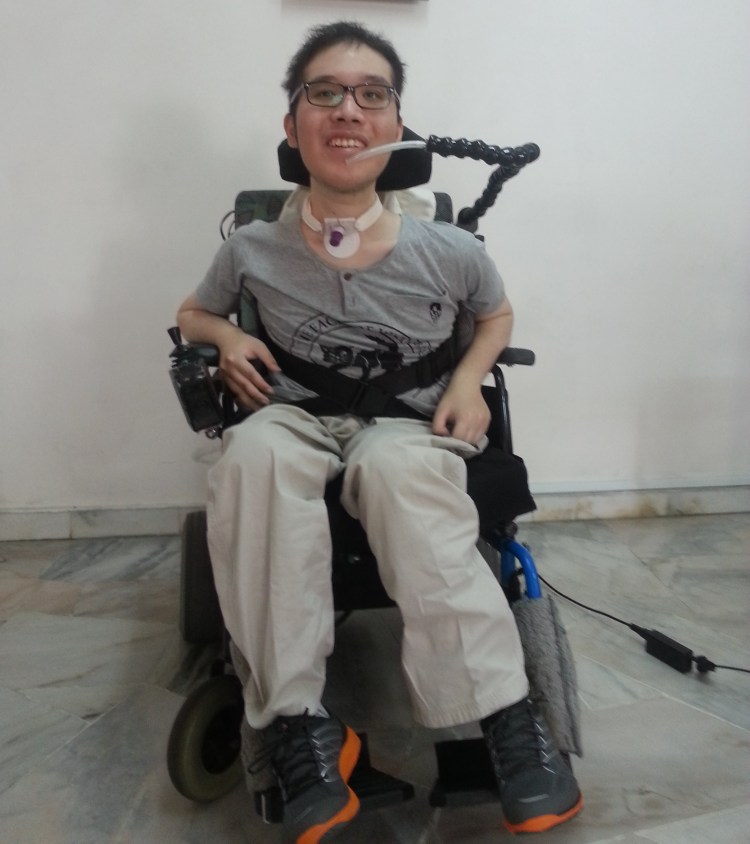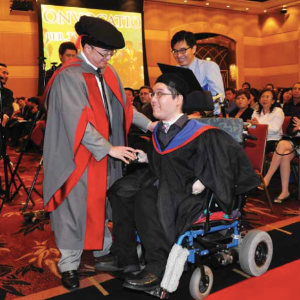At the age of six, Albert Wong was diagnosed with a condition called Duchenne Muscular Dystrophy. Doctors predicted that he would be wheelchair bound by the age of 10, though he went on to earn straight A grades and a law school scholarship.
Now in his twenties, the Malaysian law graduate is largely bed-bound and his muscles are steadily deteriorating. According to his mother, Swee Peng Yap, his hand is too weak to control the joystick of his wheelchair controller.
But if a Feb. 22 “designathon” hosted by Silicon Valley startup Emotiv is successful, Wong might some day be able to move his wheelchair using the power of his thoughts. The idea is for the community to leverage the Emotiv neuro-technology to build exciting new applications.
The goal is to build a headset for Wong to help him control his wheelchair and communicate better using a combination of mental commands, facial expressions, and head movement.
Desperate to help her son, Yap flew to San Francisco in early January to meet with tech entrepreneurs, including a former student of hers, Cheryl Yeoh. Wong’s plight eventually came to the attention of Tan Le, the Vietnam-born cofounder of Emotiv. Emotiv is a San Francisco-based company with a headset capable of picking up electrical signals from user’s brains and translating them into actions.
“Emotiv’s technology has been utilized to help people with limited mobility regain some control of their surroundings, increase ease of communication and improve overall quality of life,” said Emotiv developer relations lead Joyce Golomb in an interview. “We are eager to help Albert and would like to tap into our community.”
“Brain controlled wheelchairs are low-hanging fruit — it’s 100 percent the future for wearables,” said Redg Snodgrass, founder of a media and events startup called Wearable World. “The next step will be to gather data. The more use-cases, tests, and projects we do, the better we will get at building creating products to help people with various disabilities.”
(Disclosure: Snodgrass has done work with VentureBeat in the past.)
Wong plans to share his story with attendees via a live video stream. The hackathon participants will be invited to ask him questions about his condition, ongoing health challenges, and his future goals.
“He [Albert] wishes to be able to control his motorized wheelchair via whatever means and also to control the computer functions without using his fingers,” said Yap in an email. “Standard speech to text software does not seem to work very well for him.”
Emotiv’s team has worked with the disabled community in the past, particularly with people who are paralyzed from the neck down. Most of the designs were developed for Emotiv’s first product, EPOC. At the designathon, developers will be asked to design a wheelchair with more advanced functionality for the Insight, Emotiv’s second product, which provides the wearer with more detailed information about their brain activity.
In March of 2013, the company posted instructions on its website for hobbyists and researchers to build a brain- or mind-controlled wheelchair. The operator only needs to think “forward” or “left” or “right” to cause the wheelchair to move. All that is required is an electric wheelchair, a laptop computer, an Arduino, an interface circuit, an EPOC headset, and both ready-made and customizable software.
According to Golomb, the designathon will “validate feasibility and define the functionality and design of each application.” A few months later, the company plans to host an event for developers to build the applications. Emotiv’s team hopes the final design will benefit people with a variety of mobility problems — and not just Duchenne Muscular Dystrophy.
After he graduated with a law degree, Wong told professors at his university: “To me, all the obstacles I weathered have been worth it as I acquired a much firmer philosophical perspective on many facets of life.”
Anyone can register for the Feb. 22 hackathon to help Wong here. Watch the video below to view a mind-controlled wheelchair in action.
[youtube=http://www.youtube.com/watch?v=9wUefh58f54&w=560&h=315]



![Reblog this post [with Zemanta]](http://img.zemanta.com/reblog_e.png?x-id=efe73d7f-5c5e-46d1-bdc9-5164ad122884)

